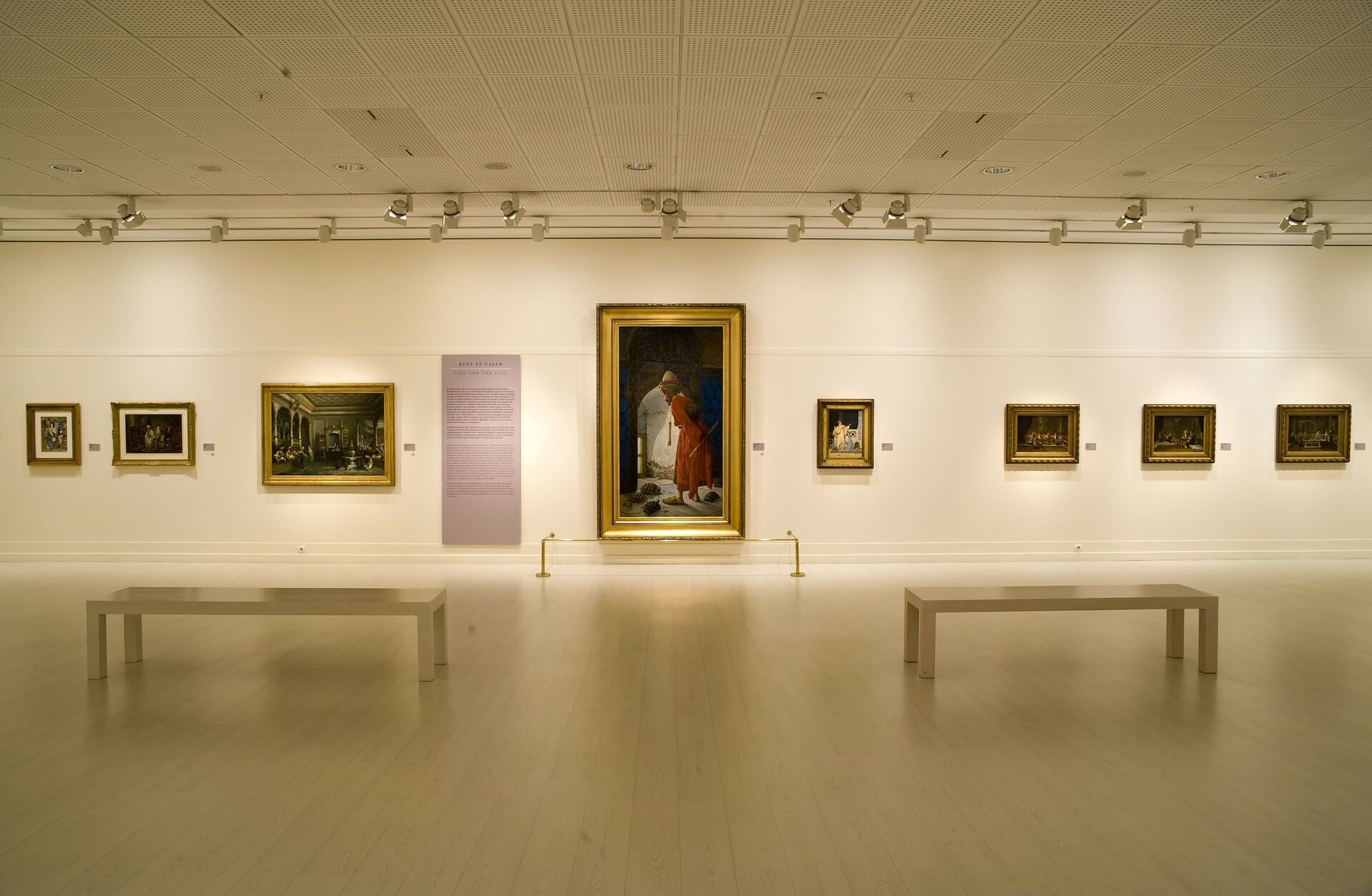Work • Capitalism
Business and the Arts
Throughout history, in most societies, bitter feuds have broken out between two rival camps, ‘business’ on the one hand and ‘the arts’ on the other.
In the business camp, have been the traders, manufacturers, entrepreneurs, financiers and the more commercially-minded politicians and scientists. And in the arts camp have been not only painters and sculptors, but also philosophers, poets, playwrights, photographers, novelists, gardeners, psychotherapists, preachers and theologians.
The hostility between the two camps has been fierce. Back in Ancient China, Confucian scholars regarded commerce as simply a lesser form of human activity.
Zhu Xi (1130—1200)
Business might be necessary, but it was a shameful life in comparison with that of learning and writing. In 18th-century Prussia, under the rule of Frederick the Great, aristocrats were forbidden by law from engaging in mercantile careers – which were thought to lack the revered military virtues of courage and honour. For the Romantic poets and artists of the 19th century, business seemed wholeheartedly uncouth and tedious.
To artistic upper class people like the French writer Robert de Montesquiou, the commercial soul seemed obsessed with embarrassing and faintly idiotic things: fluctuations in the price of guano and the search for cheaper ways of transporting cheese.
Amidst all the criticism of business by the arts, perhaps one stands out above all: business people have, it has been alleged, been deformed by their love of money; greed has withered their souls.
The world has not been enriched by this trench warfare between the arts and business. The two sides would have so much to teach one another if only they could overcome their mutual suspicions.
The stress on business greed has missed the point. The sort of business people who come in for criticism are not in fact primarily greedy. The more revealing word to use when trying to understand them is pessimistic. Despite being on the side of money, many business people have been surprisingly pessimistic about how money can be made, which is what ultimately underpins the activities that have led artists to their denunciations. Hard-headed business people are rarely outright corrupt or unnaturally avaricious: but they very often suffer from a curious kind of melancholy, a particular kind of sadness about the world and its inhabitants.
It can seem like a strange assertion to make. But this sadness shows itself in six big assumptions that operate beneath the workings of business:
One: Customers won’t give a damn about Workers
A great many businesses employ the very cheapest labour they can find on the planet. They negotiate contracts which mean people will have to work in dangerous or uncomfortable factories and warehouses.
It’s tempting to look at this from the outside and think that it is pure nastiness driving these decisions: employers screw their workers, because they are greedy, but really, it is because they are pessimistic about their customers.
Capitalists have a primordial need to stay in business. They are ready to do whatever is compatible with this aim – and if it turned out that paying staff really well and treating them to long lunch breaks was in line with this ambition, most of them would do so at once without rancour or qualm.
But they don’t, because of a pessimism about customers. Hard-nosed business people are bleakly sure that very few customers will ever care much about the well-being of their workers. These callous customers won’t give a damn how many eight-year-old children are making their trousers or how much suffering went into harvesting their tea leaves – and therefore, for businesses to start caring about such issues will simply lead to business failure. After all, the acceptability of price is all in the hands of the audience. It’s not a personal longing on the part of businesses to have people work for as little as possible. The low salaries just stem from a rather pessimistic assumption that unless businesses stick to rock-bottom wages, customers will just go elsewhere and their enterprises will fail.
Many businesses have internalised this idea very profoundly; the customer is essentially selfish.
Two: Customers have low appetites that can’t be improved
There’s a deep fear in many areas of business that high-mindedness, earnestness, and complexity are fatal to sales and that any attempt to ‘raise’ the aspirations of consumers in these directions is guaranteed to lose money.

For example, there’s a pessimism around what would happen if you tried buck the trend and promoted something healthy at the fast-food counter, or made certain magazines a bit more thoughtful or didn’t use a particular celebrity to promote your product. It wouldn’t be greed holding back corporate strategists from undertaking such initiatives. It would be a view of human nature. As the business mantra goes: no one ever failed to make money underestimating the tastes of the public.
Three: The only way to sell is through deception
There’s a painful background belief that in order to thrive, a business must use advertising to make enormous claims for its rather modest products, and ideally connect them up with semi-conscious, exaggerated promises around success and sex.
The people behind this advert don’t themselves believe that buying a music player is closely connected to the experience of physical intimacy with a gamine beauty or gentle hipster in San Francisco. But they are confronted with some gloomy facts about human nature: that people will as a matter of fact buy music machines if you present them with such images and suggestions.
Few businesses believe that advertising in its current state is admirable. If they resort to it, it is just from a desolate conclusion seemingly drawn from experience. A company can of course always choose to be above such things but sales will fall, profits will drop, they won’t be able to pay their staff; they won’t be able to raise capital and the whole venture will fold. You can participate in this charade – or you can be poor.
Four: You can only make big money from the bottom of the pyramid
It is a striking fact. Most of the big and most profitable corporations on the planet address needs grouped at the lower levels of Maslow’s famous pyramid of needs.
These businesses are efficiently targeting basic needs: for shelter, security, communication and energy. They are engaged in real estate, mining, oil, insurance or transport. None of these industries are currently very focused on any ambitious sense of what happens around their products. The oil company doesn’t care much what your journey is about, so long as you travel a lot; the real estate corporation isn’t concerned with the kind of life you live in your apartment, so long as you pay the rent.
It’s not that people in business simply don’t care about meaning, creativity and the pursuit of self-knowledge. It’s just that they have a pessimistic conviction that it is extremely hard (and almost impossible) to make money from these more elusive and private concerns.
Five: ‘Work’ is the word for what no one would do unless they were paid
There’s a belief at large, infecting the world of business, that work can’t usually be something people will feel deeply engaged by. So awful will the work be, people will just dream about the holidays and retirement. Employees are motivated primarily by money.
Therefore, if you want to recruit better staff or get people working more effectively, the key thing is to offer higher salaries. If you want a government agency to run more effectively, privatise it.
Any other thoughts about why people might work – in order to improve the lives of others, or to find an outlet for their own better natures – end up sounding simply naive and hopeless, romantic fantasies at odds with the cold facts of business life.
Six: You can’t afford to care about the psychology of your staff
This is no reflection of personal indifference to the inner lives of others; it’s just (so many people in business feel) a fairly crucial fact about running an enterprise.
If you start getting cosy and concerned about the people who work in your organisation, that’s very nice from a personal point of view, but it takes too much energy and focus away from the harsh (but essential) task of turning a profit. And if you don’t turn a profit, it doesn’t matter how kindly you feel towards your employees, you won’t be able to give them the one thing they actually most want from you: a job. Business requires the softer or more generous aspects of one’s nature to be held in check.
***
It is these pessimistic ideas about commerce and work that lead many companies – and the people who run them – to appear greedy. But we believe that the decisive factor here isn’t actually greed. It’s a pained vision of life in which any higher aspiration seems at once condemned to failure. A business has no option but to try to turn a profit, and that means it has no option but to operate by certain notions of the demands and psychology of its clients and workers. And this, the argument goes, requires the kind of capitalism we currently have.
The big claim we are making is that this pessimism is not in fact always warranted and that in order to overcome it, business should look to an unusual source for inspiration: the arts. The arts – we propose – possess a welter of antidotes to much of the underlying and painful pessimism of commerce.
If this antidote has never been explored, it’s no coincidence. It’s because business has some deep suspicions of its own when it comes to the arts. The whole field seems simply utterly useless. When you look round at what really counts in the world, none of it seems to have anything very much to do with the arts. The big corporations are concerned about millions of things – drilling rights, exchange rates, employment laws, tax credits, regional instability, technological advances. But the arts appear to be entirely marginal to all this. They are just an upmarket area of entertainment, a hobby. You might know of a CEO who paints watercolours to relax; or a wealthy family who subsidise the opera. This isn’t a problem at all. But it shows you where the arts fit in – you might get involved in the arts, once you have made money. The arts use up money, they don’t make it. Furthermore, though in theory we live in a post-gender era, the arts retain markedly and negatively ‘feminine’ connotations. Business inevitably involves tough choices; it sets a premium on the idea of being strong and masculine. So anything that hints at softness is suspect – as rendering a person unfit for the key tasks.
In essence, for business, the arts look like something you might get interested once you have succeeded. But they can’t help you succeed.
WHAT THE ARTS CAN OFFER
But both sides have, in this arena, been too pessimistic. There’s a way of considering the arts which brings out a hitherto unexplored and highly intriguing degree of value for business.

With the right mindset, we can go through the six pessimistic assumptions, one by one, and see alternative – more optimistic – attitudes that are systematically available through the history and practice of the arts.
One: The skill of exciting Sympathy
Art refuses to believe that humans don’t care about one another. It is extremely ambitious about the possibility of emotional connections between strangers. The whole basis of many artistic works has been the desire to create sympathy where none initially existed.
A primary skill of a good artist is the art of teaching us to see a common humanity beneath the surface anonymity and otherness. In the 19th century, George Eliot saw her primary task as a writer as that of helping us appreciate ‘all that is ordinary in human life’ and attuning us to the minor joys and sorrows of others, down to ‘the squirrel’s heart beat …’
Mary Ann Evans (who was published as ‘George Eliot’) extended the reach of sympathy
Her novel Middlemarch teases out the hidden dignity and honour of people living unglamorous lives – a small scale builder, a very modest farmer, a carpenter, a servant, a poor clergyman. She got large numbers of readers to feel kindly and concerned about these characters; she added new regions to the map of sympathy.
Her technique didn’t involve telling her readers they ought to care. She didn’t scold. Instead she described people’s lives carefully, feeling that the more we know about how other people are and feel, the more we will care. She was deeply against overt didacticism and lecturing about the plight of the poor. Eliot’s style was ‘psychological realism’, she gave her readers a sense of what it was to be other people, and then let readers come to their own conclusions – which they have been doing successfully for over a hundred years.
One character, in Middlemarch, Caleb Garth works as a surveyor for a new stretch of railway line that’s being planned. He’s not a very impressive figure, he never makes much money and he doesn’t do anything very dramatic. But George Eliot carefully describes how he thinks and feels about his own work and as she does so, our sympathies expand:
‘You must love your work, and not be always looking over the edge of it, wanting your play to begin. You must not be ashamed of your work, and think it would be more honorable to you to be doing something else. You must have a pride in your own work and in learning to do it well, and not be always saying, There’s this and there’s that—if I had this or that to do, I might make something of it. No matter what a man is—I wouldn’t give twopence for him”—here Caleb’s mouth looked bitter, and he snapped his fingers—”whether he was the prime minister or the rick-thatcher, if he didn’t do well what he undertook to do.”
George Eliot is demonstrating a technique for widening empathy – namely a realistic presentation of what actually goes through the minds of those who are currently overlooked.
George Eliot may be one of the most famous writers in the world’s most influential language, but she remains a very small deal on a noisy, distracted planet. Nevertheless, her example justifies a degree of confidence that wider sympathy can be engaged; a sympathy for bricklayers and surveyors, but also garment makers, tea-leaf pickers, fast-food workers and (in case we forget) bankers and CEOs. So, the pessimistic view that customers are selfish – and can’t care about the workforce, and so won’t bear the costs connected with that care – isn’t really correct.
Two: The skill of raising taste
Raising taste, means helping people come to a new appreciation of qualities and things that they hadn’t been much interested in before.
The history of culture shows some extraordinary possibilities for getting people to care about new things. For example, up until around 1919 no one had really thought that you could like a painting even though it was completely abstract – and didn’t try to represent anything.
Then along came Piet Mondrian who created a revolution in taste. He avoided painting trees or sunsets or mothers and babies so as to focus our attention more clearly on some distinctive abstract qualities: harmony, balance, purity. Mondrian was shaping and raising taste: he was assisting his audience to see the attraction and value of things of which they would otherwise have been sceptical. And he was amazingly successful. A painting by Mondrian now costs the price of a small jet aircraft.
Mondrian didn’t start out with the gloomy idea that everyone is already fixed in their preferences – and so the only way to sell anything is to go along with the choices people are already making. Otherwise, he would have stayed with the sunsets and babies. He approached public taste with the justified optimism that, in principle and with a bit of time and support, many people can be brought to recognise the appeal of novel (and interesting) things.
And if this works in relation to lines on a canvas, it must also be able to work in other more important areas than art: in the everyday, immensely significant world of food, cars, hydroelectric turbines, data storage and clothes.
Three: You can advertise good things
Business is familiar with the idea of seduction, but it takes a limited view of where seduction can be usefully deployed. The arts however, have often taken a very positive and ambitious use of seduction. They have used charm to try to ‘sell’ difficult and higher things.
The ancient Greeks, for instance, often presented rationality (the potentially austere demand that we think carefully and logically) via the god Apollo. But they made sure that Apollo was a hugely attractive character. He looked like a cross between a model and a football player. His hair was always a tumble of locks. His forearms were strong.
A classical advert – for wisdom
The optimistic assumption here is that we can be enticed towards quite elevated, noble or serious attitudes – with the help of the right sensory associations. We can be brought to confront difficult and painful – but important – tasks if they are introduced in a sufficiently alluring way. The very techniques that could be used to sell bullshit can also be deployed in selling wisdom and self-understanding.
The underlying idea is that enthusiasm for good things isn’t just the result of purely rational considerations. We get swayed by beauty, by sexual associations and by charm. We should understand and respond to these facts. Of course they can be abused. But they can also be put to very constructive use.
The Danish painter Hammershoi was, in a sense, a businessman. What he wanted to sell us was an attitude of patience, forgiveness and an appreciation of the everyday.
In order to do this, he understood that he would need to make use of all the arts of advertising. So he seductively used the nape of a lovely female neck, delicate strands of unruly hair, and a carefully calculated angle of the head, to get us to like a person and to want to enter their imaginative world. And once we’re hooked by what is – to put it bluntly – sex-appeal, he was confident we could be drawn towards tenderness and intelligent sympathy.
Moralists in the past – like the Greek writer of fables Aesop – realised that in order to make their wise correctives to our bad behaviour palatable, they’d have to use a lot of charm. They’d have to do something pretty close to advertising. Aesop invented droll stories about animals. He was sensitive to the fact that we need to be coaxed into a relaxed and playful frame of mind before we can absorb slightly tricky messages.
In one of his stories, Aesop wanted to warn us away from ruining for others what we have no use for for ourselves. So he thought up the story of the Dog in the Manger. He tells us of a dog who invaded the cow shed and set himself up in the feeding trough. He didn’t want to eat the hay himself. But he rigorously stopped the cows eating it too. It’s a charming tale, that makes us laugh, recognise bits of our own natures but doesn’t make us feel defensive or ashamed; it seduces us into accepting a difficult moral.
Aesop, the Greek sculptors and Hammershoi (along with many other artists) have shared an optimistic view of the techniques that nowadays are overwhelmingly used by advertising. They were ambitious about what they could use advertising for. It wasn’t just about trying to get us to buy superfluous shoes or cars: it was also a way of coaxing people to buy into tricky but important things.
Four: The skill of commodifying higher needs
The arts address the top level of Maslow’s pyramid of needs: they are concerned with the pursuit of meaning and the exploration of individuality and freedom. At certain key moments, the arts have succeeded in commodifying experiences in these areas and turning them into very profitable commercial operations.
For example, Impressionism – one of the most commercially successful ventures of all time (if it was a stock, it would be near the very top of most exchanges) – began when a group of painters living and working around Paris in the 1860s got very excited by the play of light, the delicate tones of shadow and the shimmering reflection of sunshine on water. They had really lovely experiences walking by rivers strolling through gardens and woodland. And they were the first people to work out how to capture those experiences effectively: they did it by focusing not on the actual shapes of thing, but on their own ‘impressions’ – and by resorting to much brighter colours than Western artist had had recourse to for centuries.
The Impressionists went onto develop this practice as a very profitable industry, which generated considerable wealth for all of the founding figures. Yet, it was a very uncynical process. Monet and his friends Pissarro, Sisley and Renoir simply focused as clearly as they could on the things they loved. They defined and intensified a range of lovely experiences that a lot of people wanted to share.
Impressionism was a commercial brand, selling its own special take on happiness
So the pessimistic idea that big profits cluster around lower needs isn’t justified. A useful way of looking at the arts is as a set of businesses directed at our elevated needs. There are enormous commercial possibilities at the top of the pyramid.
Five: The skill of motivating a workforce
The cynical – and pessimistic – idea is that at heart people only really work for money. The fact is though, across history, people have regularly been touched by other big motivating ambitions.
The Medieval monks who designed and constructed the buildings on the Scottish island of Iona didn’t have competitive salary packages. They worked because they were motivated by an idea that had been compellingly presented to them: that their labour would be pleasing to God.
And something similar is true of the modern armed forces. People join up not simply because they are going to be paid, but because they are drawn by the idea of serving their country. And they know that this might even come at a terrible price to them.
The army and the medieval church have a long elaborate tradition of creating motivation and explaining the hugely impressive purpose that drives them. They don’t see this as a minor optional extra. Explaining what the work is for, and generating a sense of its dignity, is a crucial task – which they take extremely seriously.
Churches and armies don’t have a natural monopoly on the optimistic idea that people will be driven by other things than money. They are just a couple of organisations that have been particularly ambitious around this insight.
Many corporations in fact serve the public good in important (if less overtly dramatic) ways: they keep a father with a head cold functioning well enough to pick up the children from school; they supply bathwater or provide moments of respite in a busy day in the shape of small savoury snacks. Helping people – in small but real ways – can be deeply motivating, if only we have this purpose and our part in it clearly before our eyes.
The arts are our best mechanism for transmitting ideas of purpose and ambition.
Six: How to care about staff psychology
It can seem hard-nosed, efficient and ‘grown up’ to give little attention to what’s going on inside the minds of employees. They are there to do a job. There’s been a tendency in business to give prestige to an attitude of indifference to emotional complications.
It’s not that there’s a big conviction that staff psychology is actually irrelevant to corporate success. Clearly there are ways in which an employee’s psychological hang-ups or difficulties can compromise a project: someone who is too much of a people pleaser will hold back on raising a difficult issue and thus be dangerously slow to let others know about a brewing problem; problems around rivalry mean good ideas will get rejected because of who came up with them…
Real though these issues are, dealing with them has low prestige. They might, in fact be the gateway to greater profitability than cutting a new deal, but the dealmaker will get the limelight.
The arts provide an alternative view, in which taking people’s inner lives very seriously is the mark of being successful.
Conclusion
What we’ve been seeing via the arts, is a set of reasons to be less pessimistic about business.
An incidental skill of the arts has been to correct the pessimistic account of how money can be made. Specifically the arts do this by identifying a range of skills and ideas around inner life, communication, how to change people’s minds and what you can be ambitious about.
Because we meet these things in the arts, it’s a ready assumption to think that they naturally belong in the arts. But really the arts are only a rather modest outlet for big capacities that exist far more widely. It’s more important that these abilities get used in our major industries than they are used for making things that sit in art galleries and on poetry bookshelves.











































